-

-
- Home Page || Flight 587 Page || Your Comments @ U.S.Read's Web Log
|| Send E-Mail to the Editor
|| Search U.S.Read or the Web ||
-
October 7, 2004
Analyzing The "Try Escape" Comment on the FAA Tapes
by Victor Trombettas
-
I. Could the Comment Have Come From Another FAA Controller?
-
- To answer that question we have to examine the FAA tapes.
Below follow waveforms of the transmissions captured on the FAA
tapes around the time American Airlines Flight 587 (AA 587) departed.
- The FAA Local Control tape
- Our first look is at the Local Control Tape; specifically, the
characterisitics of the landline link between the FAA centers –– Local
Control (LC) and Departure Control (DC).
In Figure 1, LC hands off, or announces, Delta Airlines Flight 2311
to DC that he (DC) is about to take over. The standard procedure
between LC and DC is for DC to simply say "check" when he receives LC's
call. LC's handoff includes just a few words ... the flight
number and the oftentimes the word "heavy". The one below is
"delta twenty three eleven". Notice how low the volume is of the
"Check" from DC (the DC workstation # that day was J108).
Figure 1

- In Figure 2 we notice the very low volume of the
"check" from DC when LC has handed off JAL 47.
- Figure 2
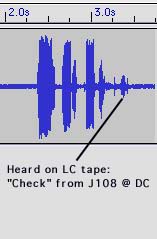
-
- In Figure 3, when LC hands off American 686, or attempts to,
instead of hearing "check", we hear "Try". It is at a much higher
volume than the other communications (the "checks") from DC were, and a
much longer transmission than "check". The volume for this phrase is
near the level of other planes, not DC's volume.
Figure 3
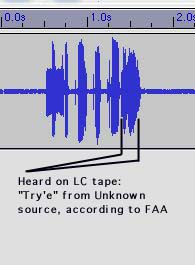
Not all the "checks" by DC are picked
up on the LC tape, making the
pickup (at a high volume) of "Try" even more unusual.
- "Try" is also on the DC tape at the same moment except there we hear the whole phrase,
"Try Escape".
The Local Control tape shows that the
source for "try escape" could not have been the DC facility –– because
the volume of "try escape" was too high compared with other
transmissions from DC.
- The FAA Departure Control Tape - NOTE TO SELF: This
section could be deleted??????????????????????????????? What's
the point????
-
- VGT HERE -->> In Figure 4 we're looking at the
handoff's from LC to DC . .
. as they
appear on the DC tape.
Figure 4 - the American 1683 handoff: 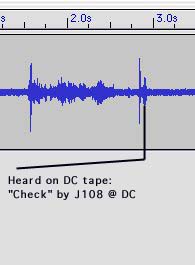
- Figure 5 - This is from American 645 and Delta 2311
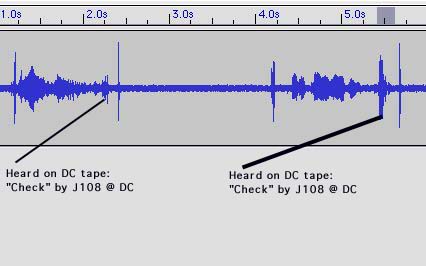
- Figure 6 - This one is the Japan Air 747 handoff:
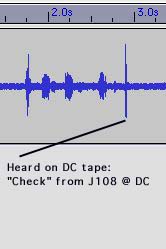
-
- This is the Flight 587 handoff. Notice how low DC's voice is
recorded at.
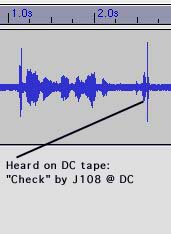
-
- Lastly, during the American 686 handoff, comes the abrupt "try
escape" transmission. The person transmitting this is not the J108 DC
Controller or else the FAA would have identified him (not to mention
the J108 voice is not the same as the "try escape" voice). If
it was someone else in DC, the recorded volume would need to be much
lower than J108's recording level because J108 is closer to his own
mike! Also, it appears J108 had keyed his mike to reply to LC, whether
he replied with his "check" or not we can't tell, but notice the mike
click below. It comes before the word escape is finished yet we
can hear the whole world. The recording could continue under this
scenario if the controller was receiving a message on his headet as he
would a message from a plane; all of those get recorded. There
is little doubt this transmission came from a plane.
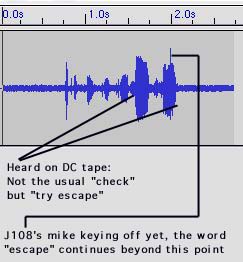
-
- All we can conclude from this transmission is that it came from a
plane that was tuned to the TRACON frequency as was Flight 587. It does
not prove it was 587. But if not 587, this should be on 587's CVR
either way because they would hear all the transmissions on that
frequency.
Why
"Try Escape" did not come from any
FAA facility
There are three factors which point strongly towards a plane
as the source of the "try escape" comment:
- 1. The much higher volume of 'Try" compared with DC.
This points away from the DC facility as the source.
- 2. LC cannot be the source because if they were, when the
transmission ends on the LC tape, as it does mid-phrase after the word
"try", it would also
end on the DC tape. But it does not. This excludes the LC facility as
the
source.
- 3. The FAA identified the source as Unknown and
specifically
told U.S.Read that they polled all their controllers and determined
that the source of this
transmission was not from any
FAA
facility –– the source was from a plane.
-
- Other Analyses
-
- Identifying the two words
-
- The two word phrase, nice game/try escape, looks like this in
waveform:

-
- It's easy to assume that the first 300 miliseconds contains the
first word, and the next 300ms the 2nd word. That would be true if the
phrase were nice game; because the speaking pause comes between "nice"
and "game". But if the phrase is "try escape", a very quickly spoken
"try escape", then the pause occurs between "try'es" and "cape".
Assuming for a moment that the phrase is "try escape", and not nice
game, the two words are identified on the waveform in this manner:
-
- This picture shows the word "Try" highlighted:

-
- This picture shows the word "Escape" highlighted:

-
-
- Group Study
- It is certainly helpful for virgin ears to have the words played
separately. Not highlighting them in the manner indicated in the
preceding two pictures will produce results like: "nice", or "knife",
or "trice", etc., for the first word, and "scape", game", or "gave",
etc., for the 2nd.
-
- I tried my method for 9 people recently. This is the manner in
which I played the entire phrase for the listener:
- 1. Played the whole phrase several times at normal speed
(44100hz). Listener had a piece of paper on which to write their
thoughts. There was zero discussion between listener and me.
- 2. Played the "try" portion (the portion I highlighted in the
picture above) several times
- 3. Played the "escape" portion several times
- 4. Played the whole phrase several times again
- 5. Slowed the whole phrase down to 34000Hz and played it several
times
- 6. asked listener for their final guess from their notes.
-
- Everyone started out with something like nice game, and ended up
with something else.
-
- Here are the results:
- 1. try escape
- 2. try escape
- 3. try escape
- 4. tie escape
- 5. try escape
- 6. something escape
- 7. type escape
- 8. I scape
- 9. something escape
-
- 8 of 9 came up with "escape". 4 of the 9 had "try". Of course,
the most important word here is escape.
-
-
-
- Is it "Nice" or "Try"?
-
- Only the first part of the phrase nice game or try escape appears
on the Local Control (LC) tape. That first part is either "nice" or
"try".
-
- Here is the first part/word from
the LC tape at normal speed; the quality of the transmission is a
bit clearer and louder on the LC tape than the Departure Control (DC)
tape.
-
- Here it is again slowed down 14%
but with no filters whatsoever applied to the voice.
-
- Here it is slowed down 25%.
-
- Do you hear "ni" or "try"? I think the "tr" sound is very clear.
To my ear there is no doubt the word is "Try" or "try e" and then it is
cut off.
-
- Here is the 2nd part of the phrase,
isolated at normal speed, from the DC tape.
-
- Here it is slowed down 14%.
-
- Do you hear "game" or "escape"?
-
- Lastly, I clipped the "Try" sound from the LC tape into a new
sound file with the escape sound from the DC tape. I'll call this the
merged file.
-
- Here is the merged file at normal
speed.
-
- Here it is slowed down 14%.
-
- Nice Game or Try Escape?
-
- Lastly, here is the full
phrase from the DC tape slowed down 14%. This is not a merged file
but the pure transmission from the DC tape.
-
- Comparisons
-
- I recorded myself saying nice game and try escape. I attempted to
use a high pitch and speak very quickly as the voice on the FAA tape.
-
-
- Here's is Victor saying nice game ... click the picture to
hear the mp3 file:
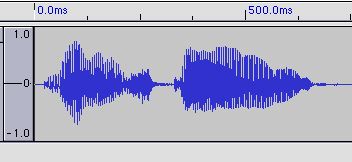
-
- Here is Victor saying try escape ... click the picture to hear
the .mp3 file:
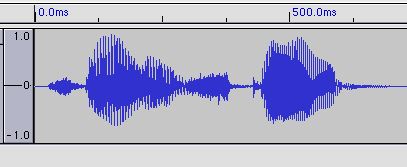
-
- Here again is the nice game/try escape phrase from 1415:51 (or
:52) on the FAA DC tape (click the picture to hear the .mp3 file):
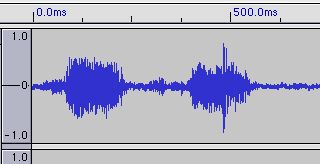
-
- Now ... I copied and pasted the first phrase (up to the center
flat line) from the FAA DC tape into a sound file. I pasted it 3 times.
So you'll hear it three times rather quickly. Following right behind
it, I pasted the first half of my nice game recording (up to
the center flat line) into the sound file 3 times. Then I pasted the
first phrase (up to the center flat line) from the FAA DC tape into the
file again (3 times), followed this time by my try escape
recording (up to the center flat line) into the sound file 3 times.
-
- Here is the first phrase Comparison mp3
file.
-
- I swear I see much more of a resemblance to my "try'es" comment
than "nice".
-
-
-
-
- Comparison of Sten Molin's Voice to the "Try
Escape" voice
-
- With the approval of Sten Molin's father, Stan Molin, I am making
available the following.
-
- I isolated a portion of Sten's voice from his home digital
answering machine where his quick, high pitched voice becomes apparent
as he says, "you've reached 8-6-9...". In this
sound file, I include that portion followed immediately by the "try
escape" voice from the Departure Control/TRACON (DC) tape. Do you hear
a similarity in pitch?
-
- Sten's father stated to me (a retired Eastern Airlines Pilot who
is still a flight instructor): "I have no doubt that it is Sten's
voice. ( I was shocked to hear his voice when I thought the comment was
Ed States.). The expression is "try escape?????" (I have no doubt that
it is a question to Ed States) The end of the "escape" is raised
intonation. I only lived with that voice for 34 and a half years. I
could be wrong, but as of now, "I have NO doubts as to the person or
the words."
-
- A friend of the Molin family, a Police Lieutenant and Pilot, who
knew Sten for 20 years, said it was Sten's voice and the words were
"try escape".
-
- We welcome your comments
and feedback
on
this article at U.S.Read's new web log at: http://usread.blogspot.com/ or
you can send us an email by clicking
here.
-















